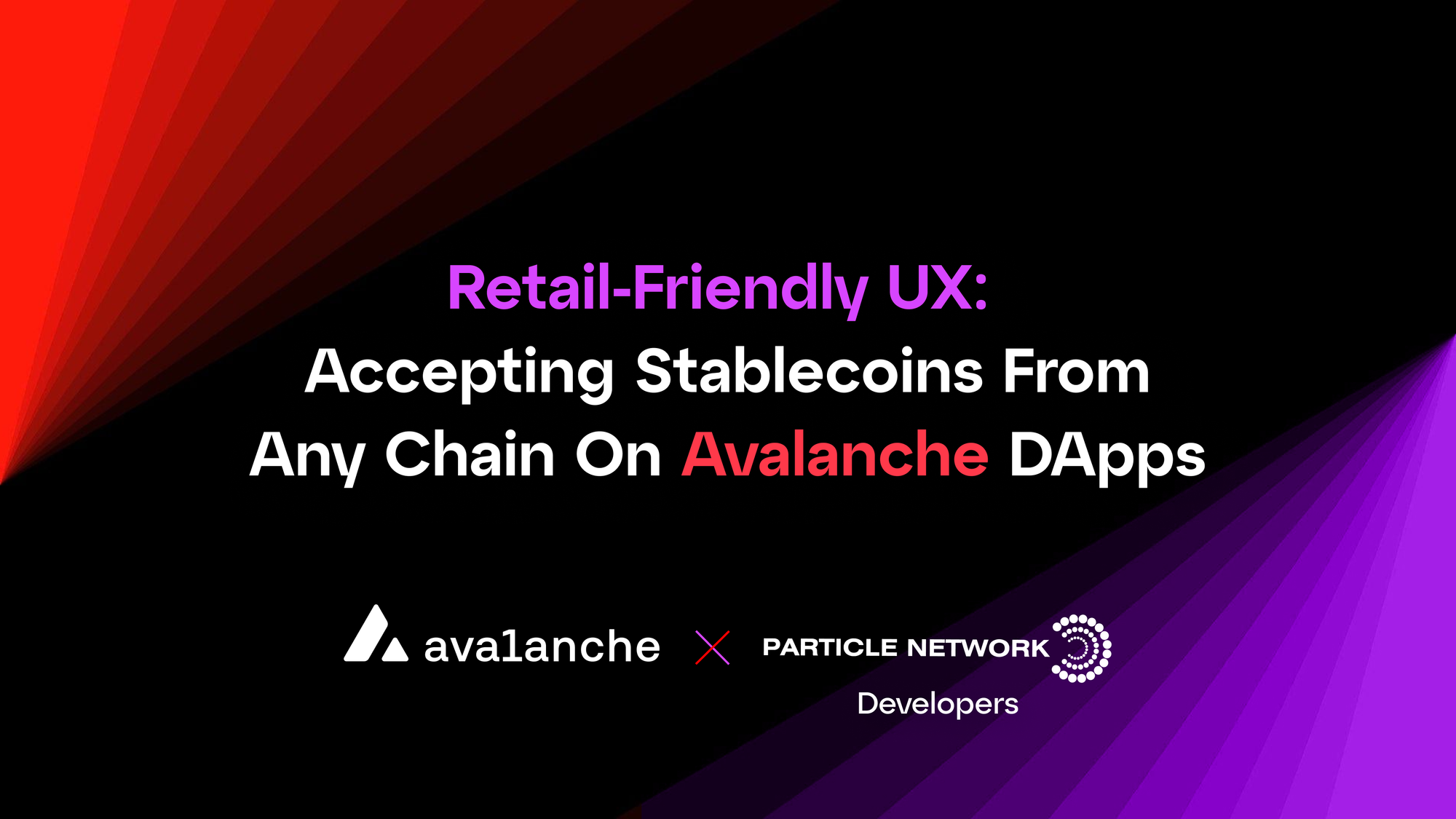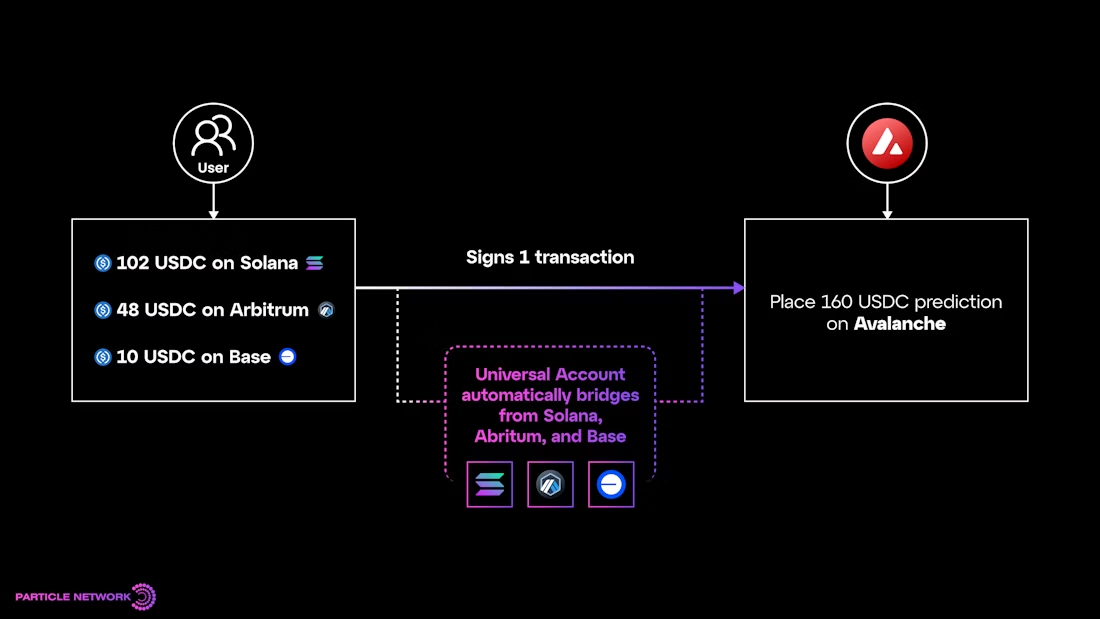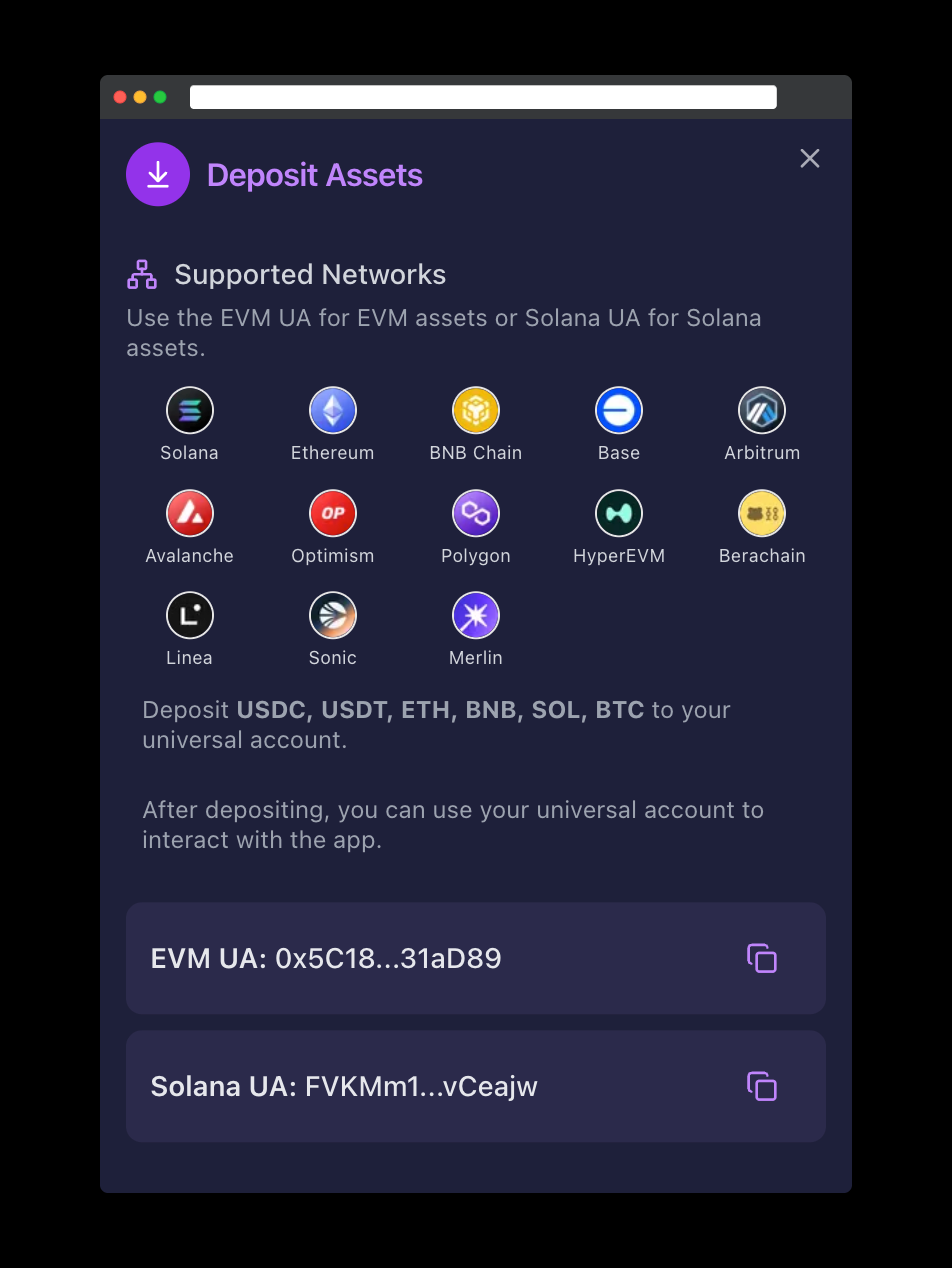Retail-Friendly UX: Accepting Stablecoins From Any Chain on Avalanche dApps

Table of Contents:
This article is a follow-up to our recent developer workshop on integrating Universal Accounts (a solution powered by our Avalanche L1, the Particle Chain) to onboard users from any ecosystem onto an Avalanche dApp. You can view the whole workshop here
Everything Wrong With Today’s Stablecoin Flow
Stablecoins should be the simplest part of Web3.
They’re liquid, familiar, boring (in a good way), and everywhere. But if you’ve ever tried accepting them in an app, you know the flow is anything but simple.
- You have to make it blatantly obvious which chain you want your users to deposit from. And still, many will complain—or worse, make mistakes.
- Bridges introduce friction, fees, and drop-offs.
- To satisfy this demand, you may end up having to deploy to an additional chain you never intended in the first place (there goes a few months of your precious time!).
So you either force users to bridge or maintain multiple deposit contracts.
Both terrible options.

Introducing Universal Accounts’ solution
Simply put, with Universal Accounts, users can deposit stablecoins from any chain to use your Avalanche (or any other chain’s!) dApp.
UAs turn fragmented user balances across multiple chains into one unified account that works everywhere.
If your app is deployed on Avalanche, Universal Accounts let your users deposit from Ethereum, Arbitrum, Polygon, Base, Solana, and more. Their balances are unified automatically, ready to be used natively on Avalanche without bridging.
This unlocks:
- One deposit flow. Users can send stablecoins from any supported chain: Ethereum, Base, Arbitrum, Polygon, Solana, and more. You can find the full list here.
- One unified balance. Your app interacts with a single account and sees the user’s total stablecoin holdings as if they were all on the same chain. They can deposit from multiple chains, and spend their unified balance in one go.
- Automatic routing. When you trigger a transaction, UAs source liquidity from wherever the user’s stablecoins live and executes on the target chain, without manual bridging or extra steps.
- Built-in gas abstraction. Users don’t need native tokens to cover fees; UAs handle this under the hood, allowing them to pay gas with their stablecoin balance.
The Larger Picture: Why This Matters
For dApp developers, every product decision eventually runs into the same roadblock: chains.
Which one to deploy on, how to support the others, and how to keep users from getting lost in between.
Furthermore, Web3 is also becoming more competitive with Web 2.0.
With a unified balance across chains, your onboarding flow suddenly looks as simple as using a FinTech dApp: users just deposit. There’s no “select a network” screen, no gas-token confusion, no bridges. They send stablecoins from wherever they hold them, and your app can immediately use those funds on any chain you operate on.
This also gives you flexibility.
You can deploy your contracts where fees are lowest or infrastructure is strongest without worrying about where user funds live. The account layer abstracts that away.
And most importantly, it converts.
Every bridge prompt, every “switch network” pop-up is one more place to lose a user. When you remove those steps, the friction vanishes… and so do the drop-offs.
How Universal Accounts work
Here’s what actually happens under the hood:
- When a user logs into your dApp, a Universal Account is initialized and linked to the users’ EOA.
- The UA gives users a single address to send USDC or USDT from any supported chain, like Ethereum, Base, Arbitrum, Polygon, Solana, etc.
- The moment their transaction lands, the Universal Account recognizes it and updates the user’s unified balance. No manual mapping, no network selection, no bridge contracts in sight.
- From that point on, your app doesn’t need to care where the funds live. When it’s time to use those stablecoins—for example, staking or buying credits in your Avalanche app—the Universal Account automatically sources liquidity from the chain where the user’s funds reside. It then routes and settles the transaction directly on Avalanche.
And, by the way, gas is abstracted too. Users don’t need ETH, POL, or SOL to cover fees; their stablecoins can handle that directly. The same pattern applies beyond deposits; any on-ramp can flow directly into a Universal Account.

Developer Experience
So far, we discussed how Universal Accounts improve UX, but they also make DevX significantly better.
Besides handling all the complexity that usually eats up dev cycles (bridging, routing, and gas management), the Universal SDK also spares you from building or maintaining chain-specific deposit logic. The SDK takes care of recognizing deposits, maintaining unified balances, and sourcing liquidity automatically.
When your app needs to use funds (stake, mint, any interaction), it’s just a single call. The SDK handles the rest behind the scenes, ensuring the transaction executes on the correct chain with the appropriate liquidity and gas token.
Build in days, not months.
Tech Implementation
If your dApp runs on Avalanche, you only need to expose your users’ Universal Account addresses to accept stablecoin deposits from any chain. Whether they send stablecoins from Ethereum, Base, or Solana, they’ll show up in your Avalanche-based app’s unified balance automatically.
To make accepting stablecoin deposits crystal clear: you don’t need to write special bridging or deposit logic. Your job is mostly to fetch and expose the user’s Universal Account address, and then let users transfer USDC / USDT to it. The UA infrastructure handles the rest.
Steps to accept deposits
- Fetch the Universal Account’s addressesAfter initializing the UA SDK for a user, call the
getSmartAccountOptions()method, which will return the UA’s addresses. This gives you the user’s:- EVM Universal Account address.
- Solana Universal Account address (to deposit Solana Assets).
Display the address in your UIShow the user their UA address(es) and instruct them on which assets they can send. You can see a sample UI here:

Once the user deposits assets, your app can let them spend those funds anywhere, without asking them to move or bridge them.
Build With Universal Accounts
Build your next Avalanche app without worrying about where your users hold their stablecoins. With Universal Accounts, you can accept deposits from anywhere and have your users spend them instantly on Avalanche.
To start building with Universal Accounts in minutes, go to:
- Docs Overview: Understand how chain abstraction works
- Supported Chains: See where Universal Accounts are live
- Universal Accounts Quickstart: Set up a working app in under 10 minutes
- Explore the SDK Reference: Full API docs for Web integration
Particle Network's Chain Abstraction solutions are 100% free for developers and teams. By integrating them, you can set your project in a path to leveraging chain abstraction.
About Particle Network

Particle Network powers chain abstraction, addressing Web3's fragmentation of users and liquidity. This is enabled by Particle's Universal Accounts, which give users a unified account and balance across all chains.
Share this article
About the author(s)


